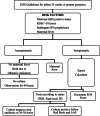Decreasing Antibiotic Use in a Community Neonatal Intensive Care Unit: A Quality Improvement Initiative
- PMID: 37607590
- PMCID: PMC11150059
- DOI: 10.1055/a-2158-8422
Decreasing Antibiotic Use in a Community Neonatal Intensive Care Unit: A Quality Improvement Initiative
Abstract
Objective: In view of the excessive use of antibiotics in our neonatal intensive care unit (NICU), we launched a 5-year multidisciplinary quality improvement (QI) initiative in our NICU in 2018. We had set our aim of decreasing the antibiotic use rate (AUR) from 22 to 17%.
Study design: The QI initiative was conducted in our 53-bed level 3B NICU. We used the core elements of antibiotic stewardship and focused on improving gaps in knowledge by using updated standards of care and a multidisciplinary approach. Outcome measures included overall AUR in NICU. Statistical control chart (P chart) was used to plot the AUR data quarterly.
Results: The AUR demonstrated a decline at the onset, and at the end of the initiative the AUR demonstrated a sustained decline to 13.18%, a 40% decrease from the baseline AUR of 22%. The changes that were implemented included development of evidence-based guidelines for babies less than and greater than 35 weeks, daily antibiotic stewardship rounds, sepsis risk calculator, antibiotic stop orders (48-hour stop, 36-hour soft stop, and 36-hour hard stop), and periodic reviews.
Conclusion: Our multidisciplinary approach using all the core elements of an antibiotic stewardship program significantly decreased AUR in our NICU.
Key points: · Excessive use of antibiotics may cause harm to the infant's health.. · Indiscriminate use of antibiotics can lead to antibiotic resistance.. · Stewardship programs can significantly decrease AUR in NICUs..
The Author(s). This is an open access article published by Thieme under the terms of the Creative Commons Attribution License, permitting unrestricted use, distribution, and reproduction so long as the original work is properly cited. (https://creativecommons.org/licenses/by/4.0/).
Conflict of interest statement
None declared.
Figures







Similar articles
-
A Quality Improvement Initiative To Optimize Antibiotic Use in a Level 4 NICU.Pediatrics. 2020 Nov;146(5):e20193956. doi: 10.1542/peds.2019-3956. Epub 2020 Oct 14. Pediatrics. 2020. PMID: 33055227
-
Pragmatic Expansion of a Neonatal Antibiotic Stewardship Program in a Community Health Care System.Pediatrics. 2024 Jan 1;153(1):e2022056356. doi: 10.1542/peds.2022-056356. Pediatrics. 2024. PMID: 38093660
-
Antibiotic stewardship in a tertiary care NICU of northern India: a quality improvement initiative.BMJ Open Qual. 2021 Jul;10(Suppl 1):e001470. doi: 10.1136/bmjoq-2021-001470. BMJ Open Qual. 2021. PMID: 34344741 Free PMC article.
-
Antibiotic Stewardship for the Neonatologist and Perinatologist.Clin Perinatol. 2021 Jun;48(2):379-391. doi: 10.1016/j.clp.2021.03.009. Clin Perinatol. 2021. PMID: 34030820 Review.
-
Antimicrobial stewardship in the NICU.Infect Dis Clin North Am. 2014 Jun;28(2):247-61. doi: 10.1016/j.idc.2014.01.005. Infect Dis Clin North Am. 2014. PMID: 24857391 Review.
Cited by
-
Baicalin, Amoxicillin, and Probenecid Provide Protection in Mice Against Glaesserella parasuis Challenge.Biomolecules. 2025 Mar 31;15(4):507. doi: 10.3390/biom15040507. Biomolecules. 2025. PMID: 40305201 Free PMC article.
References
-
- Centers for Disease Control and Prevention Prevention of perinatal group B Streptococcal disease: a public health perspective MMWR Recomm Rep 199645(RR-7):1–24. - PubMed
-
- Division of Bacterial Diseases, National Center for Immunization and Respiratory Diseases, Centers for Disease Control and Prevention Verani J R, McGee L, Schrag S J.Prevention of group B streptococcal disease MMWR Recomm Rep 201059(RR-10):1–36. - PubMed
-
- Red Book: 2018–2021 Report of the Committee on Infectious Diseases. American Academy of Pediatrics: 31st ed. 2018; 762–772

